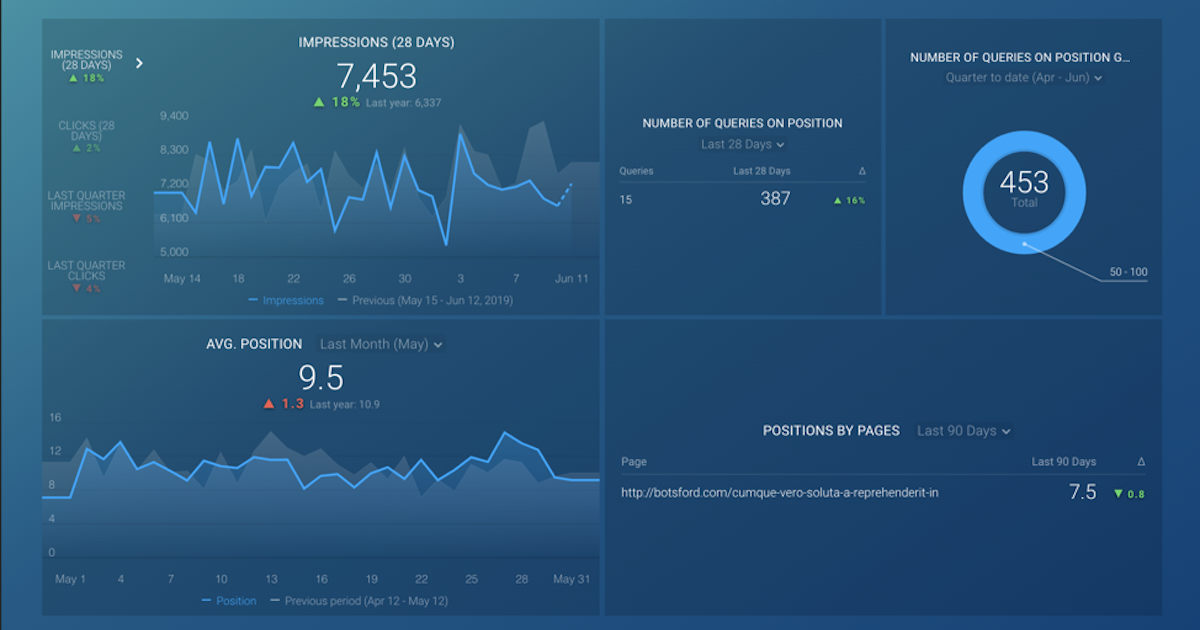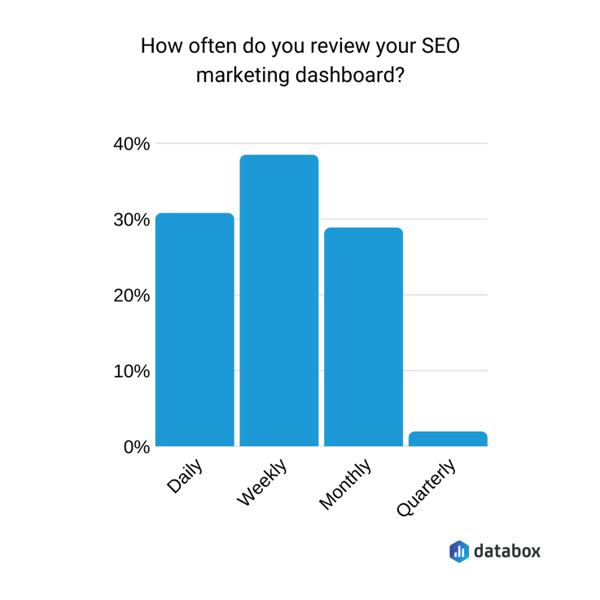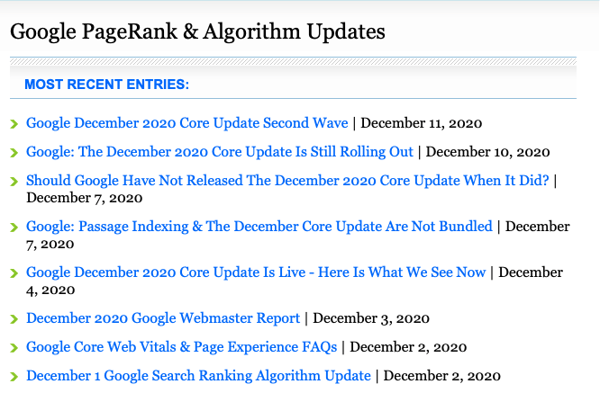The ABCs of SEO KPIs: What, How, and How Often
Written by

The perfect SEO dashboard. It might take you hours to put it together (although it doesn’t have to; we’ll show you later in this article). No matter how much effort you put in, it should include your most important SEO key performance indicators (KPIs) and a plan for progressing toward achieving your business objectives.
The only problem? SEO is notorious for taking a while to generate results. It’s estimated that SEO results require between four and six months to start kicking in.
Plus, Google can change algorithms overnight — and tank your organic traffic. Here’s the dilemma: you want to check your SEO marketing dashboard frequently enough to prevent any problems from becoming even bigger, yet you don’t want to waste time checking when nothing changes.
Let’s take a high-level look at the “what,” “how,” and “how often” of KPIs so you can measure them and demonstrate value in a tangible way.
What KPIs Are Important to Track
In order to measure the success of your SEO and digital marketing efforts, there are two main areas that demand KPI attention: overall website health and specific pages.
Here are some questions that can lead to KPIs for individual pages:
- “How visible is my page?” These metrics directly tie to a page’s performance in Search Engine Results Pages (SERPs), the pages displayed after a user query.
- “Are people finding my page?” These metrics show how many people are moving from seeing the page in a search result to visiting the page.
- Organic click-through-rate (CTR) — Of those who see my link on a SERP, what percentage actually click on it? This can be found in Google Search Console.
- Organic sessions — The “Holy Grail” for inbound marketers, organic traffic comes from search engine results; a full session is a website visit, all actions taken, and how the visitor exited the site; it’s important to note that a single user can create multiple sessions
- “How well is my page performing and converting visitors into leads?”
- Page load speed — Google wants to give searchers the best content as quickly as possible, so speed matters
- Bounce rate — This is the percentage of visitors who land on a page and leave without clicking anything else or visiting another page
- Average time on page — The average amount of time visitors spend on a page, which reveals if they’re actually reading the content
- CTA CTR — This shows the click-through-rate for the page’s main call-to-action (CTA)
Here are some ways to measure KPIs for overall website SEO health:
- Domain authority — A high score here (given by search engines) corresponds with a greater likelihood of ranking highly in SERPs; higher domain authority = preference in search results
- Aggregate of keyword ranking changes — Total keywords that rank on page 1 of a SERP, as well as the change percentage over time; you’re looking for trends to use to your advantage
- Total inbound links for your domain — Similar to above, yet these are all of the links from other sites to your entire site; you want to be an authority on the subjects covered on your site
- Total organic clicks — A huge number is obviously great, but take time to focus on the percentage change over a given time period
- “404” and other crawl errors — If Google is having trouble accessing pages on your site or reading its content, you’re in trouble; you’re also likely missing out on valuable traffic if visitors can’t use links they’ve used before; SEMrush’s Site Audit tool can show you what’s going on
- Percentage of website visitors originating from organic search — This is a huge KPI because again, high organic traffic clearly reflects SEO’s real objective: getting interested eyes reading your website; you can boost organic sessions by crafting and sharing compelling and relevant content throughout your site
Now that you know what KPIs to track, let’s explore how often you should review your SEO KPIs and dashboard.
How Frequently to Review SEO KPIs
Before we dive into creating the ideal schedule, let’s take a look at how often the average marketer looks at their SEO KPIs. Databox found that most people check their SEO marketing dashboard weekly.
Slightly over 30% look daily, and fewer than 5% check-in on a quarterly basis. Here are the numbers:

Although weekly is the most common frequency to review an SEO dashboard, it might not be the ideal timeframe for everyone.
How to set your own SEO reporting schedule
The “best” SEO dashboard review and reporting frequency depends on three things:
1. Why you’re creating and reviewing the reports
Consider the reason why you want to look at the SEO dashboard in the first place. Are you:
- Monitoring the impact of your on-page changes?
- Judging how your PR campaigns are influencing keyword rankings?
- Trying to spot a general trend for your SEO KPIs?
Your timeframe for SEO dashboard review largely depends on how you answer these and other similar questions.
The impact of on-page changes, for example, might mean you need to look at your dashboard on a weekly basis after implementing the changes.
The impact of PR campaigns could take up to a month to gain traction. As such, you may choose to review your metrics after the month ends.
Finally, trying to spot a general change in SEO KPIs might be best achieved with monthly reports. Monthly frequency gives you a wide view of your entire SEO strategy so you can more easily identify trends and results.
2. Who will be reading your SEO dashboard and reports
Agencies likely bill on a monthly basis. Likewise, a client pays upfront for work completed in the month ahead. Therefore, it makes sense to review their SEO dashboard monthly and report results once the month’s work is complete.
If you’re doing your own SEO in-house, you have more control over the frequency. The leadership team might only want to read SEO results once a quarter, but you might want to show your team how your main KPIs change on a weekly basis.
The bottom line: Think about who will be reading your SEO dashboard and reports. It will dictate your review timeline.
3. The SEO environment
Earlier, we mentioned how Google can change algorithms overnight, resulting in a dip in organic traffic for thousands of websites.
You can build this into your SEO report timing by evaluating your KPIs after an algorithm update has been released. How did it impact your website? If you’ve gone down in rankings, can you plan more changes to get back to your original position?
Sites like SERoundtable publish Google algorithm updates (see below) — even when they’re not officially announced by Google — to help you earmark SEO dashboard reviews.
Final Thoughts on the Alphabet Soup
Now you know the basics, the ABCs of SEO KPIs including how CTAs and CTRs affect SERPs. Still with me?
No matter how many acronyms are used, it should be unsurprising that there’s no perfect frequency for reviewing your SEO dashboard. What you can do, however, is dial into a timeframe that works for you based on specific variables.
Whatever timeframe you pick, stick to it. Consistency helps you better understand your KPIs and helps you track and report data relevant to your business growth.
Subscribe To Our Blog
Information. Insights. Ideas. Get notified every time a new Weidert Group blog article is published – subscribe now!
You May Also Like...

Search Engine Optimization
Optimize Your Industrial Website for AI Search

Marketing Technology
Why Unified Data Efforts Fail (and How Manufacturers Can Fix It)

Search Engine Optimization
How Falcon Rebuilt Industrial AI Search Visibility in 2025
Accelerate Your Growth with
Weidert Group
If you’re ready to explore a partnership, request a personalized consultation with our team.

